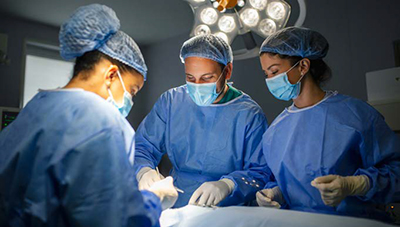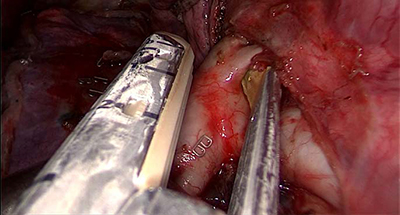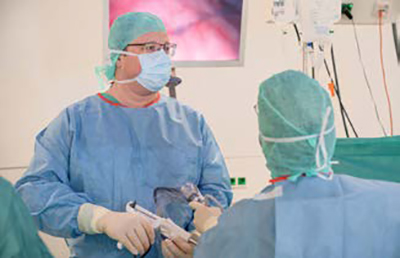The development of modern minimal invasive surgery began 1991 with the first minimal invasive anatomic resection in Milan. Since then, VATS has more and more become the standard for major resections of the lung. Improvement in instruments, cameras and powered devices also made more complex surgery like broncho- and angioplastic operations possible. The evolution of VATS now leads to uniportal VATS also combined with robotic devices, which makes also complex procedures in thoracic surgery doable with just a uniportal approach to the chest cavity. Also, artificial intelligence has begun to have an impact in medicine, especially in the diagnostics of diseases. This will mark a new area of possibilities.

At the beginning of the 20th century the german surgent Werner Körte successfully performed a lobectomy. Up to the 1980s this procedure was the standard in the treatment of not only lung cancer, but also for the management of infections and other diseases of the lung and mediastinum. Due to the development of more modern surgical instruments and the rise of laparoscopic surgery there were several surgeons seeking for a less traumatic approach for anatomical lung resections. Improvement of technical possibilities, esp. the development of good quality cameras for laparoscopy made surgeons think outside the box. As a result, in the year 1991 Giancarlo Roviaro of Milano completed a lobectomy only using minimal invasive access to the pleural cavity. After that and due to the significant reduction of perioperative pain more and more techniques evolved. Another side effect was the reduction of the hospitalization of patients and the less morbidity associated with these techniques. So, it was no surprise that this new kind of treatment spread quickly around the world.
Pioneers in the field of minimal invasive surgery like Dr. Diego Gonzales Rivas have always wanted to get the maximum out of this approach to the lung and mediastinum. Complex resections with reconstruction of bronchus and anastomosis of the pulmonary artery were first considered to be impossible by VATS. With the development of more specialized instruments even those complex resections became possible and also, the size of the incisions could be further reduced and the so called “needle-VATS” evolved.

Reduction of the number of ports led to even more reduction of pain, leading to the first lobectomy performed via uniportal VATS in the year 2010 by Dr. Rivas. Patients leaving the hospital on the 2nd or 3rd day with hardly any pain were the result of such procedures. Since then, many thoracic surgeons adopted this uniportal techniques and it spread all over the world. (Picture 1) Dr. Rivas and his team revolutionized the approach not only for small tumors, but also complex resections, which has been showed by publishing the first uniportal sleeve resection in 2013. Soon, there were not only sleeve resections performed by uniportal VATS, but also other complex resections like sulcus superior tumors or resections of the chest wall as well as reconstructions of the pulmonary artery. Also new approaches to the mediastinum like the uniportal subxiphoid approach were developed, and there was not only the resection of mediastinal mass but also the treatment of lung cancer possible through this incision which is entirely avoiding the intercostal bundle and so the pain is avoided even more.
As these techniques improved and the median age of patients is rising, not only the surgeons were looking for improvement, but also the anesthesiologists were seeking to improve the outcome for the patients, so “minimal invasive anaesthesia” in form of non-intubated VATS was re-invented, after several decades of pneumologists having a similar approach, though they were limited by instruments and lack of high-definition cameras. It has been showed, that under spontaneous breathing thorascopic procedures are safely done with less complications like pneumonia and even less systemic inflammatory reaction of the body. Therefore, it is especially suitable for the elderly patient or patients with fibrosis of the lung.
The first robotic assisted surgery on a human being took part in the year 1985 using a PUMA 200 robot arm. Since then, in the 1990ies scientists developed more specialized robotic units to fit the purpose of surgery with surgeon-controlled manipulators. This led to the approval of the DaVinci® robotic system, which is in newer Versions still in broad use today. The usage of robotic devices in thoracic surgery begun around 2008, when the first publications were done.
There are several advantages in using a robotic device in surgery, especially if there is a tight space to work within. Especially urologic procedures as the surgery of the prostate, the robotic approach is proven to have advantages. Zahid et all showed in a recent publication advantages like shorter length of stay and less complications when operative procedures are done by robotic systems. Based on this, robotic platforms became also used in thoracic surgery. By using robotic systems, the limitations of minimal invasive procedures have changed, and so has the number of operations increased. Usually, the access to the chest cavity in robotic surgery is achieved with one utilityincision, one camera-port and two further access points for instruments.
New companies like Avateramedical, the Versius robotic system by CMS and many more systems are now entering the market for robotic surgery. This will hopefully lower the prices of such systems, making them more accessible for lower volume centers and also for developing countries. Advantages of such systems are the nearly perfect 3-dimensional view, the reduction of tremor as well as the precision in working with them. Especially the training with such devices will be different and challenging in the future, as there are many different interfaces to be dealt with.
In recent years, the group of Diego Gonzales Rivas together with Dr. Mugurel Bosînceanu combined the uniportal approach with the usage of robotic surgery. After the first successful uniportal RATS in September 2021 there were several more performed by this team as they published in 2023. Due to the experience and the setup even more complex cases have been performed, such like sleeve-resections an also angioplastic procedures by just gaining accsess to the chest by a single 3 to 4 centimeter small incision. The big advantage of this method is the excellent view of structures through the 3 dimensional device which is presenting perfect view to the surgeon’s eye. Another advantage of using the robot is to improve the possibilities of movement of the used devices.
This allows a much more precise way of performing the operation compared to the stable instruments for conventional uVATS, though they might be bend for better usage.
Some centers, like the Shanghai Pulmonary Hospital, also use a Bi-portal approach for thoracic robotic surgery (B-RATS). It has been too short of a time to compare the oncological outcomes of these two methods, but first results in short term follow up show equal results in both techniques. Long term comparison of course is missing, but it is a promising way to go.
In 2023, Dr. Rivas and Dr. Zardo of the Hannover Medical School successfully performed the first ever non-intubated uniportal RATS, which is a great achievement in combining these two very modern techniques. But there is the need for new protocols in thoracic surgery to be able to implant these pioneer steps in the daily use of surgeons around the world.

Current improvement in the systems, more surgeons taking part in advanced robotic or VATS surgery will develop these techniques even more. Nowadays there are new robotic platforms available and existing ones are further developed an are currently entering the market such as the DaVinci SP®, which provides kind of a uniportal design with even more flexible arms. It is to be expected that with the increase of robotic surgeries performed the limits will be further bent. Also, other robotic systems like the vicarioussurgical-system® will enter the market, with smaller access to the bodies cavities and more degrees of freedom of movement.
With the development of artificial intelligence nowadays there is a lot of room for improvement in the treatment of a patient. There are several publications that already show the capability of AI in diagnostics. But not only in diagnostic is the AI of advantage. Also, during operations, the monitoring of the patient could be improved, and therefore the safety of anesthesiology during the procedure. By using AI in the analyzation of surgical procedures it is also to be expected to further improve the safety of the patient and the capabilities of the surgeons. As in any field, a thorough analysis of errors will lead to better quality.
The use of modern technologies like robot platforms as well as the ability of minimal invasive surgeons will definitely improve the way patients will be treated in the future. Artificial intelligence as well as machine learning will have a huge impact in medicine as well. First steps of implementing AI in diagnostic pathways have already been set with promising outcome. Therefore, it is to be expected, that the early diagnostics of not only lung cancer, but also other entities will significantly improve over the next decade. There will be a shift in diagnostics towards early-stage cancer and more people will be suitable for surgery.
References:
1. Paul Diepgen, Heinz Goerke: Aschoff/Diepgen/Goerke: Kurze Übersichtstabelle zur Geschichte der Medizin. 7., neubearbeitete Auflage. Springer, Berlin/Göttingen/Heidelberg 1960, S. 59.
2. Landreneau RJ, Mack MJ, Hazelrigg SR, et al. Prevalence of chronic pain after pulmonary resection by thoracotomy or video-assisted thoracic surgery. J Thorac Cardiovasc Surg 1994;107:1079-85; discussion 1085-6. [PubMed]
3. Walker, W.S., Carnochan, F.M. and Pugh, G.C., 1993. Thoracoscopic pulmonary lobectomy: early operative experience and preliminary clinical results. The Journal of thoracic and cardiovascular surgery, 106(6), pp.1111-1117.
4. Kyriss T, Friedel G. Needle-VATS: Erste Erfahrungen mit einer neuen Klasse von 3 mmInstrumenten und Optiken. Zentralblatt für Chirurgie - Zeitschrift für Allgemeine, Viszeral-, Thorax- und Gefäßchirurgie 2017; 142(S01): 67 - 112. doi:10.1055/s-0037-1605500
5. Gonzalez-Rivas D, Fernandez R, Fieira E, et al.Uniportal video-assisted thoracoscopic bronchial sleeve lobectomy: first report. J Thorac Cardiovasc Surg 2013;145:1676-7.
6. Gonzalez-Rivas D, Fieira E, Delgado M, de la Torre M, Mendez L, Fernandez R. Uniportal video-assisted thoracoscopic sleeve lobectomy and other complex resections. J Thorac Dis. 2014 Oct;6(Suppl 6):S674-81. doi: 10.3978/j.issn.2072-1439.2014.09.17. PMID: 25379210; PMCID: PMC4221345.
7. Aresu G, Wu L, Lin L, Jiang G, Jiang L. The Shanghai Pulmonary Hospital subxiphoid approach for lobectomies. J Vis Surg. 2016 Aug 4;2:135. doi: 10.21037/jovs.2016.07.09. PMID: 29078522; PMCID: PMC5637559.
8. Anile M, Vannucci J, Ferrante F, Bruno K, De Paolo D, Bassi M, Pugliese F, Venuta F; NIVATS Interest Group. Non-Intubated Thoracic Surgery: Standpoints and Perspectives. Front Surg. 2022 Jul 1;9:937633. doi: 10.3389/fsurg.2022.937633. PMID: 36034396; PMCID: PMC9407015.
9. Leal Ghezzi T, Campos Corleta O. 30 Years of Robotic Surgery. World J Surg. 2016 Oct;40(10):2550-7. doi: 10.1007/s00268-016-3543-9. PMID: 27177648.
10. Gharagozloo F, Margolis M, Tempesta B. Robot-assisted thoracoscopic lobectomy for earlystage lung cancer. Ann Thorac Surg. 2008 Jun;85(6):1880-5; discussion 1885-6. doi: 10.1016/j.athoracsur.2008.02.085. PMID: 18498788.
11. Zahid A, Ayyan M, Farooq M, Cheema HA, Shahid A, Naeem F, Ilyas MA, Sohail S. Robotic surgery in comparison to the open and laparoscopic approaches in the field of urology: a systematic review. J Robot Surg. 2023 Feb;17(1):11-29. doi: 10.1007/s11701-022-01416-7. Epub 2022 May 8. PMID: 35526260.
12. Möller T, Steinert M, Becker T, Egberts JD. Robotik in der Thoraxchirurgie [Robotics in thoracic surgery]. Chirurg. 2020 Aug;91(8):689-698. German. doi: 10.1007/s00104-02001210-x. PMID: 32514941.
13. Pardolesi A, Bertolaccini L, Brandolini J, Solli P, Novellis P, Veronesi G. Four arms roboticassisted pulmonary resection-left upper lobectomy: how to do it. J Vis Surg. 2018 May 22;4:109. doi: 10.21037/jovs.2018.05.04. PMID: 29963398; PMCID: PMC5994468.
14. https://medizin-und-technik.industrie.de/markt/aus-der-branche/avatera-op-roboter-ausjena-als-alternative-zum-davinci-system/
15. Peters BS, Armijo PR, Krause C, Choudhury SA, Oleynikov D. Review of emerging surgical robotic technology. Surg Endosc. 2018 Apr;32(4):1636-1655. doi: 10.1007/s00464-018-60792. Epub 2018 Feb 13. PMID: 29442240.
16. Gonzalez-Rivas D, Bosinceanu M, Manolache V, Gallego-Poveda J, Garcia A, Paradela M, Dunning J, Bale M, Motas N. Uniportal fully robotic-assisted major pulmonary resections. Ann Cardiothorac Surg 2023;12(1):52-61. doi: 10.21037/acs-2022-urats-29
17. Gonzalez-Rivas D, Bosinceanu M, Manolache V, Gallego-Poveda J, Paradela M, Li S, Garcia A, Bale M, Motas N. Uniportal fully robotic-assisted sleeve resections: surgical technique and initial experience of 30 cases. Ann Cardiothorac Surg. 2023 Jan 31;12(1):9-22. doi: 10.21037/acs-2022-urats-23. Epub 2023 Jan 6. PMID: 36793981; PMCID: PMC9922765.
18. Ning Y, Chen Z, Zhang W, Zhu Y, Jiang L. Short-term outcomes of uniportal robotic-assisted thoracic surgery anatomic pulmonary resections: experience of Shanghai Pulmonary Hospital. Ann Cardiothorac Surg. 2023 Mar 31;12(2):117-125. doi: 10.21037/acs-2022-urats18. Epub 2023 Mar 28. PMID: 37035648; PMCID: PMC10080333.
19. Wang R, Gonzalez-Rivas D, Wang C, Gao J, Lan L, He J, Li S. Non-intubated uniportal roboticassisted thoracic surgery: the future of thoracic surgery? Ann Cardiothorac Surg. 2023 Jan 31;12(1):49-51. doi: 10.21037/acs-2022-urats-15. Epub 2022 Dec 7. PMID: 36793984; PMCID: PMC9922776.
20. https://www.vicarioussurgical.com/
21. Ouyang D, He B, Ghorbani A, Yuan N, Ebinger J, Langlotz CP, Heidenreich PA, Harrington RA, Liang DH, Ashley EA, Zou JY. Video-based AI for beat-to-beat assessment of cardiac function. Nature. 2020 Apr;580(7802):252-256. doi: 10.1038/s41586-020-2145-8. Epub 2020 Mar 25. PMID: 32269341; PMCID: PMC8979576.
22. Wijnberge M, Geerts BF, Hol L, Lemmers N, Mulder MP, Berge P, Schenk J, Terwindt LE, Hollmann MW, Vlaar AP, Veelo DP. Effect of a Machine Learning-Derived Early Warning System for Intraoperative Hypotension vs Standard Care on Depth and Duration of Intraoperative Hypotension During Elective Noncardiac Surgery: The HYPE Randomized Clinical Trial. JAMA. 2020 Mar 17;323(11):1052-1060. doi: 10.1001/jama.2020.0592. PMID: 32065827; PMCID: PMC7078808.